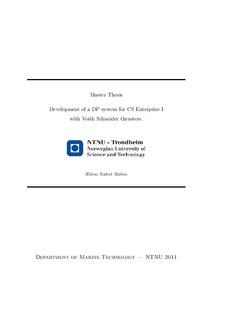| dc.description.abstract | A model ship named CS Enterprise 1 (CSE1) has been purchased by the Norwegian University of Science and Technology (NTNU) to be used for demonstrations and student experiments at the Marine Cybernetics Laboratory (MC Lab). This model ship has in this project been equipped with two Voith Schneider Propellers (VSPs), and a new bow thruster, in addition instrumentation for these new actuators have been installed. Once the outfitting was completed, the aim was to develop a manual thruster control, joystick mode control, and a Dynamic Positioning (DP) system. In order to develop a DP system a system identification of the vessel was needed. This was performed by a combination of measurements and analysis from free-running tests using Matlabs System Identification ToolBox (SITB).
CSE1 were equipped with VSPs, a new bow thruster, and instrumented in the MC Lab. A manual thruster control was developed, where a PlayStation 3 (PS3) controller was used for user input, allowing the operator to control all the vessels actuators precisely and simultaneously. For the system identification, the linear surge and sway damping were found by towing the model ship at different speeds, and measuring the drag forces with force sensors. Force sensors were also used to measure the thrust from the VSPs and the bow thruster at different set-points. Then-free-running tests were conducted, where the position and orientation of the vessel as well as the thruster set-points were recorded. This data was then fitted to a simplified DP model, using Matlabs SITB. The results from these analyzes were rejected as the standard deviation for the results were to high, and the method failed to provide consistent results. The vessel parameters from another model ship about the same size and geometry were therefore adopted to form the basis of the tuning of the DP controller. A proper Human Machine Interface (HMI) where created in LabView to monitor and control the vessel for all operational modes. This HMI includes a 3D window that displays the position and orientation of the model ship in real time. A Hardware In the Loop (HIL) simulator has also been implemented in order to test the DP controller, and verify signal routing and saturations.
With the performed upgrades and instrumentation of CSE1 the vessel should be well suited for demonstrations and student experiments. The use of the PS3 controller provided a great way to control the model boat. The method of using SITB for system identification partially failed because the simplified DP model was used, and this model does not include some of the dynamics of the input data used. A more sophisticated model should be used as a grey-box model as this might improve the reliability of the estimated parameters. After some tuning of the DP controller and thrust allocation a working DP system were demonstrated, even though the DP system had some performance issues.
| nb_NO |
